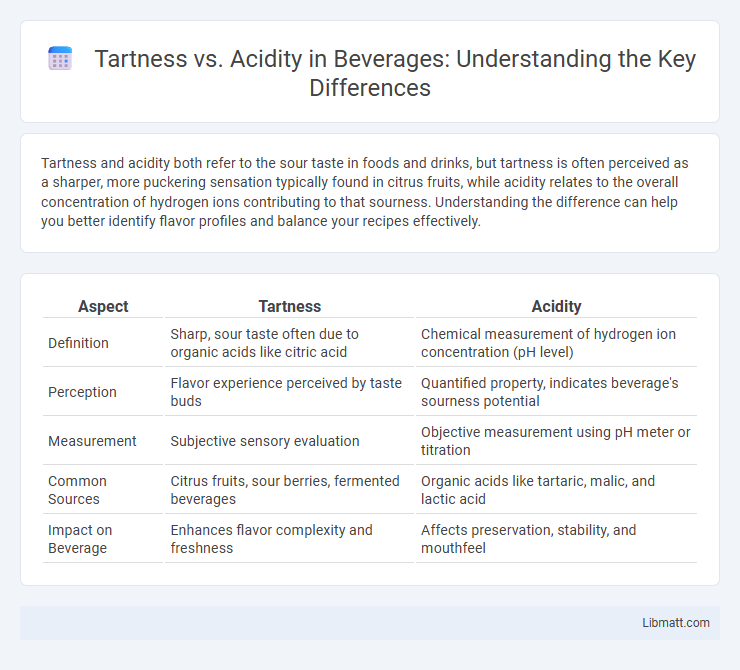Tartness and acidity both refer to the sour taste in foods and drinks, but tartness is often perceived as a sharper, more puckering sensation typically found in citrus fruits, while acidity relates to the overall concentration of hydrogen ions contributing to that sourness. Understanding the difference can help you better identify flavor profiles and balance your recipes effectively.
Table of Comparison
| Aspect | Tartness | Acidity |
|---|---|---|
| Definition | Sharp, sour taste often due to organic acids like citric acid | Chemical measurement of hydrogen ion concentration (pH level) |
| Perception | Flavor experience perceived by taste buds | Quantified property, indicates beverage's sourness potential |
| Measurement | Subjective sensory evaluation | Objective measurement using pH meter or titration |
| Common Sources | Citrus fruits, sour berries, fermented beverages | Organic acids like tartaric, malic, and lactic acid |
| Impact on Beverage | Enhances flavor complexity and freshness | Affects preservation, stability, and mouthfeel |
Understanding Tartness: Definition and Characteristics
Tartness is a sharp, tangy sensation often associated with high levels of organic acids such as citric acid and malic acid found in fruits like lemons and green apples. It is a specific type of acidity perceived on the taste buds, characterized by a bright, zesty flavor that stimulates saliva production. Unlike general acidity, tartness refers specifically to the intense sourness that provides a refreshing and palate-cleansing quality in various foods and beverages.
What Is Acidity? Scientific Explanation
Acidity refers to the concentration of hydrogen ions (H+) in a solution, which determines its pH level and sour taste intensity. In food and beverages, acidity is caused by organic acids like citric, malic, and tartaric acids, influencing flavor balance and preservation. Tartness is a sensory perception of acidity, often experienced as a sharp, biting taste due to these acids interacting with taste receptors.
Key Differences Between Tartness and Acidity
Tartness refers to the sharp, puckering taste sensation often linked to sour fruits like lemons or green apples, while acidity describes the chemical concentration of hydrogen ions in a substance, influencing its sourness level. Acidity is quantified by pH levels, with lower pH indicating higher acidity, whereas tartness is a sensory perception affected by both acidity and other flavor compounds. Understanding this distinction is crucial for food science and culinary applications, as acidity impacts preservation and microbial stability, while tartness primarily affects flavor profile and consumer preference.
How Tartness and Acidity Impact Flavor Perception
Tartness and acidity both contribute to the sharpness and brightness of flavors, influencing how food and beverages are perceived on the palate. Tartness typically refers to a direct, often sour sensation associated with compounds like citric acid, creating a lively, tangy taste that enhances freshness. Acidity encompasses a broader range of organic acids that not only add sourness but also balance sweetness, intensify aromas, and affect the overall flavor complexity.
Sources of Tartness in Foods and Beverages
Tartness in foods and beverages primarily originates from organic acids such as citric acid, malic acid, and tartaric acid found in fruits like lemons, apples, and grapes. Vinegar, containing acetic acid, and fermented products also contribute to tart flavor profiles. The concentration and type of acids influence the perceived sharpness and mouthfeel, distinguishing tartness from general acidity.
Common Foods High in Acidity vs. Tartness
Common foods high in acidity include citrus fruits like lemons, limes, and oranges, as well as vinegar and tomatoes, which contain organic acids such as citric and acetic acid that contribute to their sharp, sour taste. Tartness, often perceived in foods like green apples, cranberries, and unripe cherries, is a specific sensation caused by the presence of certain organic acids, primarily malic and tartaric acid, offering a crisp and tangy flavor profile. Understanding the distinction between acidity and tartness helps in culinary applications, where acidity influences overall pH balance and preservation, while tartness impacts flavor intensity and mouthfeel.
Measuring Tartness and Acidity: Explained
Measuring tartness involves evaluating the sensory perception of sourness, often influenced by organic acids like citric or malic acid in foods. Acidity quantifies the concentration of hydrogen ions, typically measured by pH levels or titratable acidity tests in laboratory settings. Understanding these distinctions helps you accurately assess flavor profiles and quality in beverages or culinary applications.
The Role of pH in Taste Sensation
pH plays a crucial role in distinguishing tartness from acidity in taste sensation, with lower pH levels generally enhancing sourness perception, which is commonly described as tart. Acidity refers to the concentration of hydrogen ions in a solution, directly influencing how sharply sour or tart your taste buds perceive a food or beverage. Understanding the pH balance helps you better control flavor profiles in cooking and food production by managing the intensity of sour and tart characteristics.
Balancing Tartness and Acidity in Cooking
Balancing tartness and acidity in cooking enhances flavor complexity by providing a harmonious contrast between sharpness and brightness. Ingredients such as citrus juice, vinegar, and fermented products offer acidity, while tartness often comes from sour fruits like green apples or tamarind, creating a dynamic taste profile. Proper balance prevents overpowering sour notes and ensures dishes remain vibrant and appetizing, especially in sauces, dressings, and marinades.
Tartness vs. Acidity: Health Implications
Tartness and acidity, while related, differ in their sensory perception and impact on health; acidity refers to the chemical concentration of hydrogen ions that can contribute to dental erosion and digestive issues, whereas tartness signals a sharp, puckering taste often linked to beneficial antioxidants found in citrus fruits. High dietary acidity may exacerbate acid reflux and enamel wear, emphasizing the need to balance acidic food intake with neutralizing agents like calcium-rich foods. Tartness, associated with compounds such as citric and malic acids, can stimulate saliva production, aiding digestion and potentially reducing risk factors for certain oral and gastrointestinal conditions.
Tartness vs acidity Infographic

 libmatt.com
libmatt.com